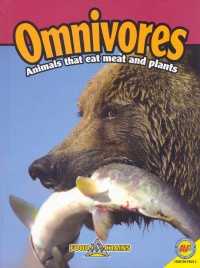| ________________
CM . . . . Volume XVIII Number 34 . . . . May 4, 2012
excerpt:
Heather C. Hudak's Omnivores provides an introductory look at the eating habits of omnivores, how these animals are important in the food chain, and how these consumers must be protected to avoid extinction. The book opens with an explanation of how producers and consumers work in a food chain, and then it introduces different kinds of omnivores, including both what and how they eat. After descriptions of the omnivores' habitats and locations where they can be found around the world, Omnivores concludes with a quiz on the information from the book. One of the strengths of Omnivores is that the language and content has not been watered down for a young audience; rather, the writing is sophisticated enough to be accessible to young readers while still providing scientifically accurate information. It is quite useful that Hudak bolds key words and provides a glossary at the back of the book. The text is supplemented with photographs of animals captured in their real habitats. The use of photographs instead of illustrations aids in visually supporting the information, as well as adding to the feel of sophistication of the book. Omnivores is an AV² Media Enhanced Book, which means it has additional information online. Readers can access the website and input a code found on the first page of the book to see games and worksheets complementary to the text. There is a wide variety of activities ranging from links to external websites and outlines explaining how to structure an essay. While these online additions are excellent for young readers to access while at home or at the library, they are perhaps best used as a teaching tool in a classroom setting. The most glaring flaw of Omnivores lies in the general appearance and layout of the text. The book uses several different fonts on the same page, and they often do not work together for visual harmony. Striking "funky" fonts are paired with several kinds of non-serifed text, all under large maroon headers on the top left page. The colours of the bolded asides on each page – vibrant greens and neon pinks – do not meld well with the muted jewel tones of the rest of the headers. The appearance is an unfortunate element of what is an otherwise great, informative book for young readers. Recommended. Jillian Sexton has a B.A. (Hons) from Memorial University and will begin her MA in Communication from Carleton in the fall of 2012. She currently lives in St. John's, NL.
To comment
on this title or this review, send mail to cm@umanitoba.ca.
Copyright © the Manitoba Library Association. Reproduction for personal
use is permitted only if this copyright notice is maintained. Any
other reproduction is prohibited without permission.
NEXT REVIEW |
TABLE OF CONTENTS FOR THIS ISSUE
- May 4, 2012.
AUTHORS |
TITLES |
MEDIA REVIEWS |
PROFILES |
BACK ISSUES |
SEARCH |
CMARCHIVE |
HOME |
